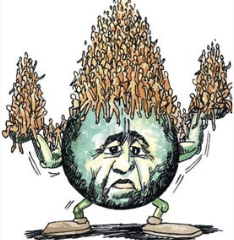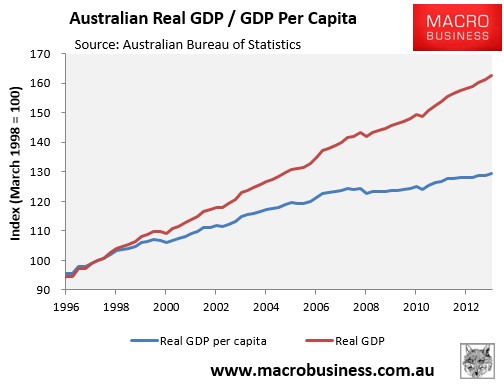
Alan Kohler has today uncovered the key ingredient behind Australia’s recent economic growth: the population ponzi:
It’s perfectly clear what is now taking over as the main driver of Australia’s economic growth: population.
In the 1990s, it was the productivity growth that resulted from the microeconomic reforms of the Hawke Government. In the 2000s, it was the increase in commodity prices resulting from Chinese demand.
Productivity growth finished long ago, and the investment boom is coming to an end now. Although mining and energy exports will continue to support GDP, the burning question is: what will replace resources investment as the new driver of growth?
The answer is people, or more specifically, the infrastructure required to house, feed and transport them.
Last year Australia’s population grew 1.8 per cent — the most in the Western world…
Without that, the new boom in city infrastructure needed to cope with the increase in population will simply lead to higher costs. Its impact would be negated by making Australia less competitive, leading to higher interest rates to deal with inflation.
The key issue in all this is whether expanding Australia’s population by more than 1 million people every three years is beneficial to the existing population. Sure, while it might be great for Australia’s business elites – who enjoy the fruits of an expanded market – it imposes real costs on the rest of us, who must endure increased costs of congestion, higher infrastructure costs, lower environmental amenity, and minimal uplift in material economic well-being.
From a narrow economic perspective, population growth (immigration) is good only if it raises the real incomes of the pre-existing population (e.g. real GDP per capita). While it is true that Australia’s high population growth over the second half of the 2000s boosted Australia’s real GDP (more labour inputs, other things equal, means more outputs), evidence is sketchy as to whether real GDP per capita increased due to population growth. In fact, as the below chart shows, real GDP per capita has remained lacklustre since 2007, suggesting that while the overall economic pie has increased in size because of high population growth, everyone’s share of that pie has barely grown.

The question around living standards becomes more important when infrastructure constraints and the environment are taken into account.
Indeed, a big negative of Australia’s high rate of population growth is that it is placing increasing pressure on the pre-existing (already strained) stock of infrastructure and housing, which reduces productivity and living standards unless costly new investments are made. Further, controversial investments like desalination plants would arguably not have been required absent such population growth.
Further, when infrastructure and housing investment fails to keep up, it places upward pressure on inflation, requiring higher interest rates, which can then damage productive sectors of the economy. As explained in a 2011 speech by the Reserve Bank of Australia’s Phil Lowe (summarised here), these factors were certainly in play in the late-2000s, when rapid population growth placed upward pressure on rents, as well as caused a big surge in utilities prices as the capacity of the system struggled to keep pace with the growing demand, requiring costly new investments.
Ongoing high population growth also places additional strain on the natural environment, causing greater environmental degradation, increasing water scarcity and pollution, and making it more difficult for Australia to reduce its carbon footprint and meet international pollution reduction targets.
A related concern is that Australia earns its way in the world mainly by selling its fixed mineral resources (e.g. iron ore, coal, natural gas, and gold). More people means less resources per capita. A growing population also means that we must deplete our mineral resources faster, just to maintain a constant standard of living.
But don’t just take my word for it. Modelling by the Productivity Commission has also found that immigration is neither beneficial for the economy or living standards, nor can it alleviate the impacts of an ageing population.
All of which raises the question: what is the end-game of Australia’s current population-based economic model? If all we are doing is growing for growth’s sake, pushing against infrastructure bottlenecks, diluting our fixed endowment of minerals resources, and failing to raise the living standards of the existing population, where does it lead?

